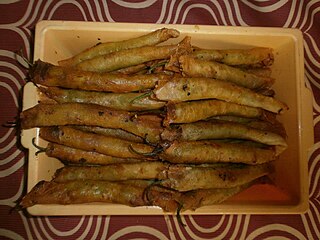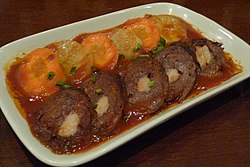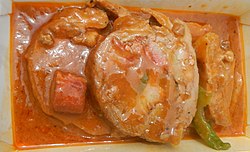
Chorizo is a type of pork sausage originating from the Iberian Peninsula. It is made in many national and regional varieties in several countries on different continents. Some of these varieties are quite different from each other, occasionally leading to confusion or disagreements over the names and identities of the products in question.

Meatloaf is a dish of ground meat that has been combined with other ingredients and formed into the shape of a loaf, then baked or smoked. The final shape is either hand-formed on a baking tray, or pan-formed by cooking it in a loaf pan. It is usually made with ground beef, although ground lamb, pork, veal, venison, poultry, and seafood are also used, sometimes in combination. Vegetarian adaptations of meatloaf may use imitation meat or pulses.

Fried rice is a dish of cooked rice that has been stir-fried in a wok or a frying pan and is usually mixed with other ingredients such as eggs, vegetables, seafood, or meat. It is often eaten by itself or as an accompaniment to another dish. Fried rice is a popular component of East Asian, Southeast Asian and certain South Asian cuisines, as well as a staple national dish of Indonesia. As a homemade dish, fried rice is typically made with ingredients left over from other dishes, leading to countless variations. Fried rice first developed during the Sui dynasty in China.

Salvadoran cuisine is a style of cooking derived from the nation of El Salvador. The indigenous foods consist of a mix of Amerindian cuisine from groups such as the Lenca, Pipil, Maya Poqomam, Maya Chʼortiʼ, Alaguilac and Cacaopera peoples and some African influences. Many of the dishes are made with maize (corn). There is also heavy use of pork and seafood. European ingredients were incorporated after the Spanish conquest.

Murtabak, or Mutabbaq, is a stuffed pancake or pan-fried bread commonly found in the Arabian Peninsula, the Indian subcontinent, and Southeast Asia, notably in Saudi Arabia, Yemen, Indonesia, Malaysia, Singapore, Brunei, and Southern Thailand. Depending on the location, the name and ingredients can vary significantly. The name mutabbaq means "folded" in Arabic.

Czech cuisine has both influenced and been influenced by the cuisines of surrounding countries and nations. Many of the cakes and pastries that are popular in Central Europe originated within the Czech lands. Contemporary Czech cuisine is more meat-based than in previous periods; the current abundance of farmable meat has enriched its presence in regional cuisine. Traditionally, meat has been reserved for once-weekly consumption, typically on weekends.

Hamonado, or hamonada, is a Filipino dish consisting of meat marinated and cooked in a sweet pineapple sauce. It is a popular dish during Christmas in Philippine regions where pineapples are commonly grown. Hamonado is also a general term for savory dishes marinated or cooked with pineapple in the Philippines.

Lumpia(in Indonesian and Filipino) are various types of spring rolls commonly found in Indonesian and the Filipino cuisines. Lumpia are made of thin paper-like or crepe-like pastry skin called "lumpia wrapper" enveloping savory or sweet fillings. It is often served as an appetizer or snack, and might be served deep-fried or fresh (unfried). Lumpia are Indonesian and Filipino adaptations of the Fujianese rùnbǐng and Teochew popiah, usually consumed during Qingming Festival.

Embutido, or embotido, is a Philippine meatloaf made with ground pork and stuffed with hard-boiled eggs and sliced ham or various sausages. It is traditionally wrapped in aluminum foil and steamed, though it can also be baked.

Afritada is a Philippine dish consisting of chicken, beef, or pork braised in tomato sauce with carrots, potatoes, and red and green bell peppers. It is served on white rice and is a common Filipino meal. It can also be cooked with seafood.

Pininyahang manok, commonly anglicized as pineapple chicken, is a Philippine dish consisting of chicken braised in a milk or coconut milk-based sauce with pineapples, carrots, potatoes, and bell peppers. Some variants of the dish use a chicken stock base instead of milk. The dish originates from Southern Luzon which was once a regional center of pineapple fiber production in the Spanish Philippines.

Paelya or paella (Spanish) is a Philippine rice dish adapted from the Valencian paella. However, it differs significantly in its use of native glutinous rice (malagkít), giving it a soft and sticky texture, unlike the al dente texture favoured in Spanish paella. It is also characteristically topped with sliced eggs. Filipino paelya does not use saffron, but is instead coloured with atsuete (anatto), luyang diláw (turmeric), or kasubhâ (safflower).

Filipino spaghetti is a Filipino adaptation of Italian spaghetti with Bolognese sauce. It has a distinctively sweet sauce, usually made from tomato sauce sweetened with brown sugar, banana ketchup, or condensed milk. It is typically topped with sliced hot dogs or smoked longganisa sausages, giniling, and grated cheese. It is regarded as a comfort food in Philippine cuisine. It is typically served on almost any special occasion, especially on children's birthdays.

Dinamita is a deep-fried Filipino snack consisting of stuffed siling haba wrapped in a thin egg crêpe. The stuffing is usually giniling, cheese, or a combination of both but it can also be adapted to use a wide variety of ingredients, including tocino, ham, bacon, tuna, and shredded chicken. Dinamita is also known as dynamite lumpia, among other names. It is a type of lumpia and it is commonly eaten as an appetizer or as a companion to beer.

Philippine asado refers to two different Filipino braised meat dishes. The name originates from Spanish asado ("grilled"), a reference to the original dish it was applied to, the Chinese-Filipino version of char siu barbecues usually known as pork asado. However, the Filipino versions have evolved to be braised, not grilled. The other Filipino dishes also known as asado are asado de carajay and asado matua. Unlike the Chinese-derived version, they are savory rather than sweet.

Indo cuisine is a fusion cooking and cuisine tradition, mainly existing in Indonesia and the Netherlands, as well as Belgium, South Africa and Suriname. This cuisine characterized of fusion cuisine that consists of original Indonesian cuisine with Eurasian-influences—mainly Dutch, also Portuguese, Spanish, French and British—and vice versa. Nowaday, not only Indo people consume Indo cuisine, but also Indonesians and Dutch people.

Chicken galantina, also known as chicken relleno, is a Filipino dish consisting of a steamed or oven-roasted whole chicken stuffed with ground pork (giniling), sausage, cheese, hard-boiled eggs, and various vegetables and spices. It originates from the 19th-century Spanish dish galantina de pollo, which in turn is derived from the French galantine dishes. It is popularly served during Christmas dinner in the Philippines. It is typically eaten with white rice or with bread.




















